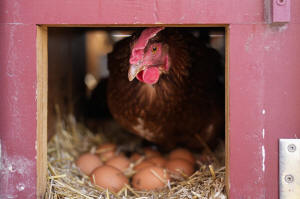Communal sweating in saunas is the hottest wellness trend taking over
the UK
[March 13, 2025]
By JOSH FUNK
OMAHA, Neb. (AP) — Vaccines could be a key means of suppressing bird flu
and avoiding the slaughter of millions of chickens, which is blamed for
egg prices averaging nearly $6 a dozen. But the move has been delayed in
part because of concerns it could jeopardize chicken exports worth
billions of dollars a year.
The U.S. Department of Agriculture has announced plans to spend $100
million to study bird flu vaccines to fight the disease in concert with
meat chicken, egg and turkey groups. That's part of a larger $1 billion
effort to invest in more protections to keep the virus off farms that
President Donald Trump believes will help lower egg prices.
Chicken meat producers remain the most resistant to vaccines because of
concerns they could harm meat exports, which totaled nearly $4.7 billion
last year. Egg and turkey producers sell most of their products in the
U.S. and have been hit hardest by the virus.
Why is a vaccine needed?
Without a new policy including vaccines, the government will continue to
slaughter every flock with a bird flu infection to limit the spread of
the disease. Those deaths have totaled over 166 million birds in the
U.S. since 2022.
Most birds killed are egg-laying chickens, and the death of so many hens
is the main reason egg prices keep rising. The average price per dozen
has hit $5.90, and in some part of the country, it is far higher.
Poultry veterinarian Simon Shane, who runs www.Egg-News.com, said the
government is hesitant to use vaccines and change its policy of killing
birds largely because of the meat chicken industry's opposition.
“Basically this is a political issue, and this only came to a head
because eggs are at $8 to $9 a dozen, and it’s embarrassing the
government — embarrassing the present administration,” Shane said.

Why doesn't the US use a bird flu vaccine?
Before using vaccinations, the government must decide how to devise an
effective system and monitor for outbreaks within vaccinated flocks that
might not show any symptoms, said John Clifford, the USDA's former
longtime chief veterinary officer, who now works with a poultry industry
export group. Once that is figured out, the industry can negotiate with
countries to minimize trade problems.
“What the industry wants is the ability to develop the strategic plan to
share that with the trading partners and then find out what kind of
impact that that will have on trade,” Clifford said.
There are fears that vaccinating could allow the virus to linger
undetected in flocks and mutate in ways that could make it more of a
threat to humans and allow sick birds to get into the food supply. Like
with other diseases, properly cooking chicken to 165 degrees Fahrenheit
(74 degrees Celsius) will kill bird flu, but the industry and chicken
buyers don't want it there at all.
For meat chicken, known as broilers, the virus isn't as significant
because those birds are slaughtered at 6 to 8 weeks old and thus have
less chance of being infected compared with egg-laying hens, which live
to 2 years or older. Also most broilers are raised in the Southeast,
which hasn't had as many outbreaks as the Midwest and West.
[to top of second column]
|

A Red Star hen, a hybrid breed that lays large brown eggs, stands on
eggs inside her coop at Historic Wagner Farm, Friday, Feb. 7, 2025,
in Glenview, Ill. (AP Photo/Erin Hooley, File)
 Another delay to vaccinating
concerns distribution. Egg farmers want to administer it through
chicken feed or water, saying it's not practical to give shots to
millions of birds in a single barn.
It can also be difficult to tell the difference between a vaccinated
bird and one that has been sick with the virus. That would make
other countries nervous about importing meat.
“People have talked about how expensive it would be
to monitor vaccinated populations. And it would be. But where do we
want to spend our money?” said Dr. Carol Cardona, a bird flu expert
at the University of Minnesota. “We’re spending our money hand over
fist right now in depopulation and to buy eggs for breakfast.”
What does the experience in other countries show?
China and Mexico have been vaccinating their poultry for years, but
they take different approaches.
In Mexico chicken are vaccinated, but Clifford said the country
doesn't slaughter flocks when infections are found. That basically
ensures the virus is present in poultry.
China still slaughters vaccinated flocks when infections are found,
which has proven more effective at limiting the spread of the virus
and reigning in outbreaks.
Clifford said the U.S. would need to continue culling flocks with
outbreaks even after vaccinating, and it might make sense to give
shots only to egg layers and turkeys, not broilers.
Will it help egg prices?
Don't expect big relief anytime soon.
The USDA, which did not respond to a request for comment for this
article sent last week, clearly isn't moving to vaccinate
immediately. And, regardless, it will take time to raise new hens.
“We’re going to have to wait to replace those with new hatched
chicks, and it takes 20 weeks before they even start laying,” Shane
said. “So I don’t know where they’re going to get the eggs from.”
Prices may ease somewhat later this year after peak demand, which
happens around Easter, if massive egg farms in Iowa, Ohio,
California and elsewhere can avoid more outbreaks.
The USDA has predicted that average egg prices will be 41% higher
than the 2024 average of $3.17 per dozen. That would mean $4.47 per
dozen, slightly below the current average.
All contents © copyright 2025 Associated Press. All rights reserved
 |